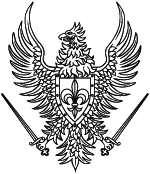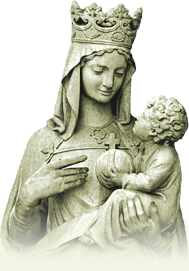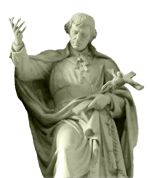Arts
Doctrine and Art
H. Wyndisch
According to the common sense art has one single end: to please. If it were said that the artistic works can be, and are, powerful means to spread ideas, they, surprised, would doubt it. And this is “the state of ideological innocence" which eases the assimilation of false religious, philosophical and ideological systems through art.Modern Art, with its systematic deformation of reality created by God, is, in fact, an emerging of the demoniac (cf. SEDLMAYER, H. - L’art du démoniaque ou Le démonie de l’art). The hatred which it manifests to the creatures that were made by God results of the deepest hatred: the hatred to the God Creator, the hatred to the being. Modern Art is a riot against all aesthetical laws and even against the Metaphysical order. Well then, revolt and Metaphysical hatred are essential elements of Gnosis, the greatest underlying lie to all heresies.
Gnosis means knowledge. It is not any knowledge, though; it is a pretentious knowledge of the incomprehensible, that is, of God. Some irrational knowledge which would save god, who is man, from the three prisons that withhold him: matter, moral and reason.
According to Gnosis, the deity would not be a being, but a not being, a perpetual flow determined by the dialectic shock of contrary principles which compose it. The dialectic evolution of deity would have produced emanations and one of these emanations would have created the world, imprisoning the divine eons in the matter.
Therefore, inside of each being there would have a particle of the deity. To keep these particles confined in the material universe, the demiurge creator – truly god of evil – would have imposed the Decalogue. Moreover, creating a rational world and giving intelligence to man, God would make him believe this world is logical and good, would make him wish not to leave it to return to the initial deity.
Here are some basic ideas of Gnosis:
1) Deity is confined in the universe. The infinite is contained in the finite.There would be much more to say about Gnosis, but we wish to limit ourselves to these characteristics, for they are the ones which clearly appear in the works of the Dutch graphic artist M. C. Escher (1898-1972), one of the most baffling artists of our times.
2) Dialectic evolutionism. Everything is transformed by the shock of contrary and equal principles which compose all beings.
3) Dualism. God and Evil, Light and Dark, Beauty and Ugly, Matter and Spirit are identical and contrary poles which constitute all reality.
4) Radical Equalitarianism. At the end, everything is just one: the deity.
5) Relativism. Nothing has a steady value.
6) “Analogism”. The world created by the demiurge is a caricature of the divine plerome (amount of deity emanations). The inferior reality is the inverted image, as a deformed mirror of the divine reality.
7) Magic. The laws which rule the world are illusory. The true laws are those which rule secretly the relations of divine particles immersed in the material world.
Based on the studies of Arabic mosaics and in theories of crystallography, Escher created images of a fantastic and paradoxical world.
We will not consider the technical value of the work of this artist but how he exposes a Gnostic conception of the universe.
The first thing to mention regards Escher’s worries when disclosing that the infinite is inside the finite. He does so by representing equal figures which have their height reduced from the center to the borders of a circle or vice-versa.
Escher sees the finite universe not only as a prison of the infinite, but also as something exempted of free spaces. Everything is filled by forms. Everything is made of angels and demons, good and evil, light and dark. In the world conceived by Escher, the figures fulfill each other, having the same graphical value and, evidently, the same symbolic value. Good is equivalent to evil, as well as light is to dark. Everything has its same Metaphysical value. As it approaches the edge of the circle, there is a tendency to eliminate completely the distinction of elements, suggesting a unifying synthesis of angels and demons, of good and evil, light and dark. Thus the author’s dualist and Gnostic message becomes evident.
Another important idea of Gnosis disclosed in the works of this artist concerns the dialectics, in others words, the equivalence of contraries. Escher symbolizes this idea not only equaling angels to demons, but also making even the superior to the inferior, the interior to the exterior, day to night, life to death, dream to reality, and the ascending and descending.
Escher, therefore, turns into a kind of “Zenon” of graphic printings. His works are authentic visuals sophisms where perspective artifices create optic illusions wherein the contraries seem to be the same. An amazing example is his work “Waterfall”, where water, always running down, will at last “go up” to fall down harshly again from the high, as a false perpetual-motto.
All this leads to total relativism, which Escher represents in his work “Ascending and Descending”, where monks go up and down endless stairs, which end always to the same point.
The Gnostic idea that the created world is an inverted image of the Divine plerome world was symbolized by many authors through the mirror. Escher retakes this symbol with extraordinary ability.
To Gnosis, the world created by the demiurge is in constant dialectic evolution. A universal metamorphosis makes the beings pass from the inanimate world to the animated world, from the rational to the divine. Also to the core theme of metamorphosis, Escher dedicated many works.
Finally, the Gnostic and therefore anti-catholic meaning of this author’s works is crystal clear in the work in which mummified bodies of priests have the distich under their feet: “Ite, missa est.”, which means “Go, the mass is over”, insinuating the end of catholic religion. How tragic this sentence taken from the liturgy of the traditional Mass turns out to be when we consider the catastrophic situation of our religion in the present days…
Para citar este texto:
"Doctrine and Art"
MONTFORT Associação Cultural
http://www.montfort.org.br/eng/veritas/arte/doutrina/
Online, 23/12/2025 às 12:28:15h








